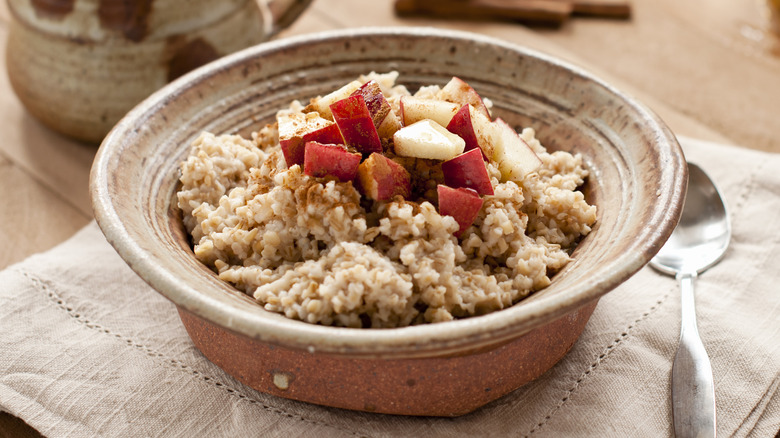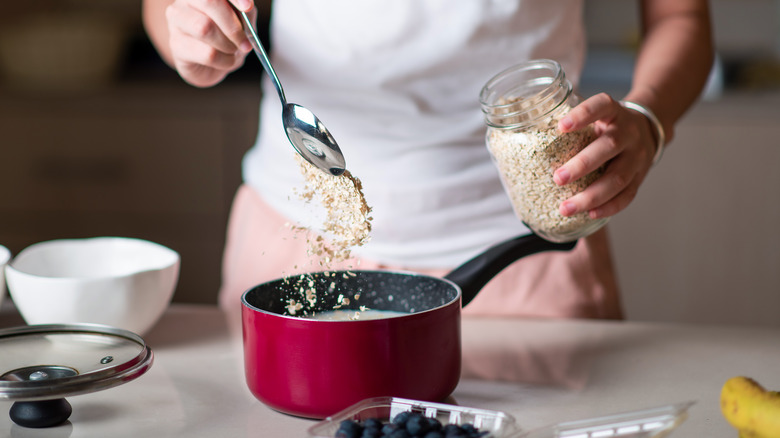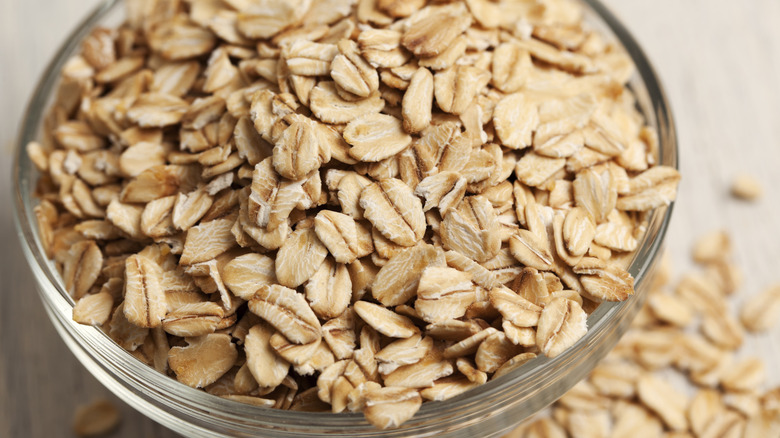For The Best Oatmeal Texture, Skip The Boiling Liquid
A big bowl of hot oatmeal is one of the most comforting and easy ways to begin the day, and such a simple and versatile dish doesn't seem like it could be improved. However, what if we told you that making the best bowl of oats likely involves ignoring the instructions on the package? We're talking about the part where you're supposed to boil the oats in water or milk. It might sound odd, but it's actually wiser to take things slow.
Among the common mistakes everyone makes when cooking oatmeal, rushing the process is high on the list. For the creamiest oatmeal with just the right amount of chewy and hearty texture, resist the urge to crank your stove to maximum heat and vigorously boil your oats in liquid. Instead, bring your oatmeal to a boil for only a brief time, then reduce the heat and simmer the grains to finish.
This gentler method of cooking may even save you time in the end, since you won't have to babysit the pot and stir it constantly to prevent sticking, nor will you have to spend part of your morning scrubbing burnt oats off the bottom of your pan. The scientific reason why your oats turn out better with this method will convince you that it's worth trying.
Why you should simmer oats instead of boiling them
Cooking oats them makes them much easier to digest through a process known as gelatinization. When added to hot liquid, the starches in the oats absorb the moisture and thicken the water, milk, or other liquid you use to cook them. Slow and even absorption of the liquid causes the individual grains to break down into a smooth and slightly sticky texture. You might think using higher heat is simply a way to speed up gelatinization, but in reality, it's doing your oatmeal more harm than good.
Temperature is crucial in determining the consistency of oatmeal. When oats are forcefully boiled, they're more likely to cook unevenly, with some pieces crusting on the bottom of the pan and others becoming mushy. Oats need time to properly soften and release their starches, and cutting down on that time doesn't lead a bowl of perfect oats in a quicker timeframe — it just leads to worse results.
For the ideal balance of creamy goodness and firm oats in every bite of oatmeal, the trick is to slowly simmer the grains, allowing them to gradually take in liquid. And while you can add a splash of milk to your pot of oats, using mostly water to cook them works better. The oats will be less likely to turn too thick and sticky.
Another easy step makes your oatmeal even better
Once you use the proper amount of patience to cook oatmeal, you'll likely be stunned at the great results, and might wonder how you can make your morning meal even better. Flavorings like cinnamon and maple syrup can certainly kick up some oats, while savory toppings like eggs and scallions can make your breakfast more filling, but to upgrade even the most basic bowl of oatmeal, try toasting the oats.
It may seem like an unnecessary step, but toasting your oats is worth it for the depth of flavor it adds to oatmeal. The process of toasting ingredients like oats or nuts intensifies their flavors by browning them and concentrating their taste and aroma. This can add complexity and warmth to the taste of your oatmeal, and can even save you some time, since you're essentially pre-cooking them before boiling them. You can toast oats on a sheet pan in the oven or in a dry skillet on the stovetop, and either option takes just a few minutes.
Part of what makes toasting so great is that it can upgrade your oatmeal using no extra ingredients, and it can improve both sweet and savory recipes. With that being said, you may want to also toast oatmeal add-ins like almonds or coconut flakes. These ingredients will take on a nutty sweetness and add crunch to your bowl of perfectly creamy yet hearty oatmeal.



